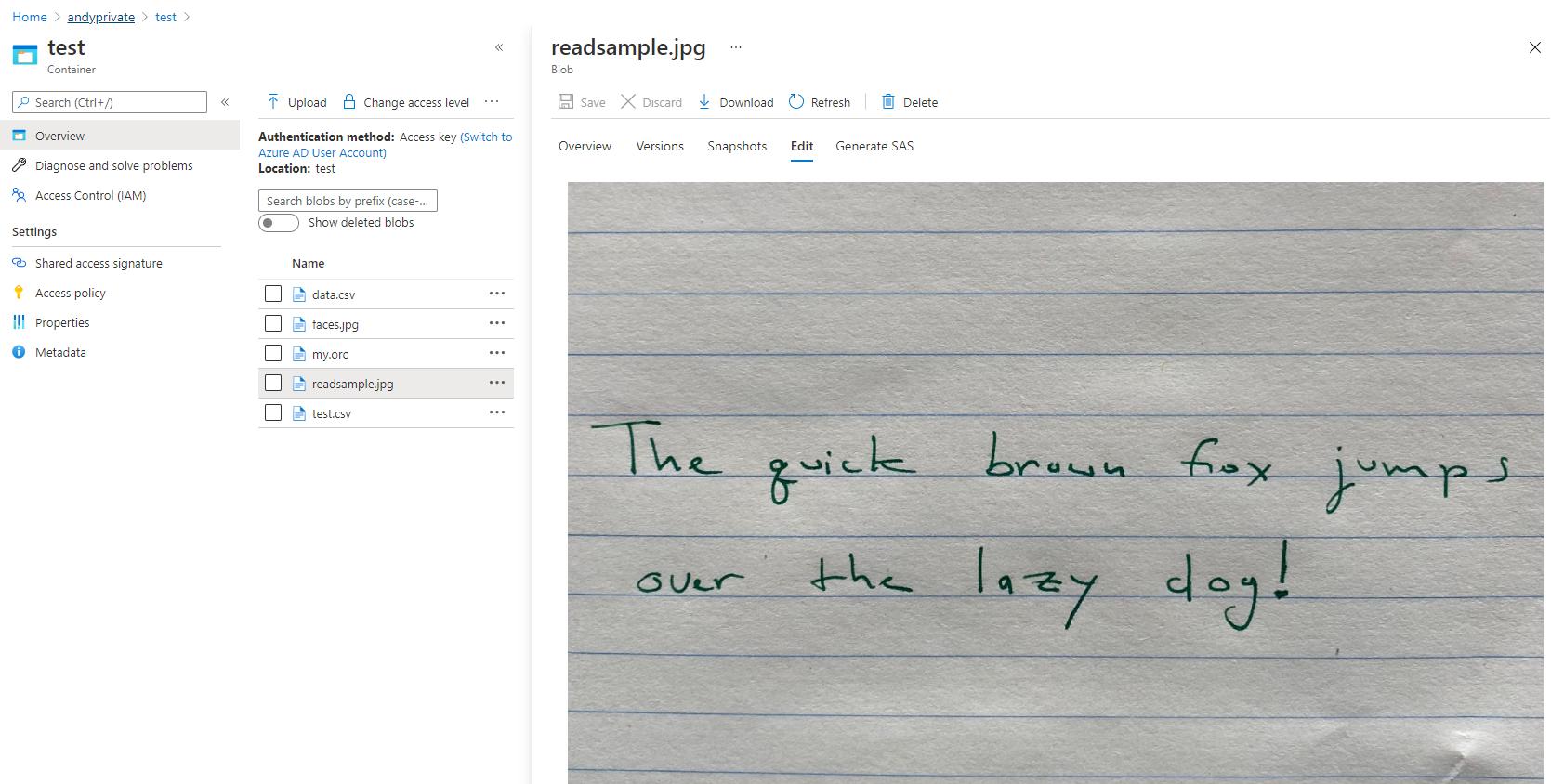Azure Storage (Put Blob )
Azure Storage (Put Blob )
提问于 2021-04-13 10:52:09
我正在尝试使用Azure rest来放置一个blob。我成功地提出了一个"GET“请求,但是我对"PUT”请求有异议。当我试图发出"PUT“请求时,我会得到一个403错误(服务器无法验证请求)。确保授权头的值是正确的,包括签名。)。我在堆叠堆里看到过同样的帖子,但对我没什么帮助。有什么建议吗?
string uri = string.Format("https://{0}.blob.core.windows.net/{1}/LibraryForm.png", storageAccountName,containerName);
Byte[] requestPayload = File.ReadAllBytes(imagepath);
using (var httpRequestMessage = new HttpRequestMessage(HttpMethod.Put, uri)
{ Content = (requestPayload == null) ? null : new ByteArrayContent(requestPayload) })
{
// Add the request headers for x-ms-date and x-ms-version.
DateTime now = DateTime.UtcNow;
httpRequestMessage.Headers.Add("x-ms-date", now.ToString("R", CultureInfo.InvariantCulture));
httpRequestMessage.Headers.Add("x-ms-version", "2020-06-12");
httpRequestMessage.Headers.Add("x-ms-blob-type", "BlockBlob");
httpRequestMessage.Headers.Add("x-ms-blob-content-type", "image/png");
// Add the authorization header.
httpRequestMessage.Headers.Authorization = GetAuthorizationHeader(
storageAccountName, storageAccountKey, now, httpRequestMessage);
// Send the request.
using (HttpResponseMessage httpResponseMessage = await new HttpClient().SendAsync(httpRequestMessage))
{
if (httpResponseMessage.StatusCode == HttpStatusCode.OK)
{
var str = httpResponseMessage.Content.ReadAsStringAsync().Result;
return str;
}
}
}
internal static AuthenticationHeaderValue GetAuthorizationHeader(string storageAccountName, string storageAccountKey, DateTime now,
HttpRequestMessage httpRequestMessage, string ifMatch = "", string md5 = "")
{
// This is the raw representation of the message signature.
HttpMethod method = httpRequestMessage.Method;
String MessageSignature = String.Format("{0}\n\n\n{1}\n{5}\n\n\n\n{2}\n\n\n\n{3}{4}",
method.ToString(),
(method == HttpMethod.Get || method == HttpMethod.Head) ? String.Empty
: httpRequestMessage.Content.Headers.ContentLength.ToString(),
ifMatch,
GetCanonicalizedHeaders(httpRequestMessage),
GetCanonicalizedResource(httpRequestMessage.RequestUri, storageAccountName),
md5);
// Now turn it into a byte array.
byte[] SignatureBytes = Encoding.UTF8.GetBytes(MessageSignature);
// Create the HMACSHA256 version of the storage key.
HMACSHA256 SHA256 = new HMACSHA256(Convert.FromBase64String(storageAccountKey));
// Compute the hash of the SignatureBytes and convert it to a base64 string.
string signature = Convert.ToBase64String(SHA256.ComputeHash(SignatureBytes));
// This is the actual header that will be added to the list of request headers.
// You can stop the code here and look at the value of 'authHV' before it is returned.
AuthenticationHeaderValue authHV = new AuthenticationHeaderValue("SharedKey",
storageAccountName + ":" + Convert.ToBase64String(SHA256.ComputeHash(SignatureBytes)));
return authHV;
}
private static string GetCanonicalizedHeaders(HttpRequestMessage httpRequestMessage)
{
var headers = from kvp in httpRequestMessage.Headers
where kvp.Key.StartsWith("x-ms-", StringComparison.OrdinalIgnoreCase)
orderby kvp.Key
select new { Key = kvp.Key.ToLowerInvariant(), kvp.Value };
StringBuilder sb = new StringBuilder();
// Create the string in the right format; this is what makes the headers "canonicalized" --
// it means put in a standard format. http://en.wikipedia.org/wiki/Canonicalization
foreach (var kvp in headers)
{
StringBuilder headerBuilder = new StringBuilder(kvp.Key);
char separator = ':';
// Get the value for each header, strip out \r\n if found, then append it with the key.
foreach (string headerValues in kvp.Value)
{
string trimmedValue = headerValues.TrimStart().Replace("\r\n", String.Empty);
headerBuilder.Append(separator).Append(trimmedValue);
// Set this to a comma; this will only be used
// if there are multiple values for one of the headers.
separator = ',';
}
sb.Append(headerBuilder.ToString()).Append("\n");
}
return sb.ToString();
}
private static string GetCanonicalizedResource(Uri address, string storageAccountName)
{
StringBuilder sb = new StringBuilder("/").Append(storageAccountName).Append(address.AbsolutePath);
// It will have more entries if you have more query parameters.
NameValueCollection values = HttpUtility.ParseQueryString(address.Query);
foreach (var item in values.AllKeys.OrderBy(k => k))
{
sb.Append('\n').Append(item).Append(':').Append(values[item]);
}
return sb.ToString().ToLower();
}回答 1
Stack Overflow用户
发布于 2021-04-14 02:51:52
如果您想用rest将文件上载到Azure Blob,请参阅fooliwng代码。
我定义了一个类来获取ShareKey
internal static class AzureStorageAuthenticationHelper
{
internal static AuthenticationHeaderValue GetAuthorizationHeader(
string storageAccountName, string storageAccountKey, DateTime now,
HttpRequestMessage httpRequestMessage, string ifMatch = "", string md5 = "")
{
// This is the raw representation of the message signature.
HttpMethod method = httpRequestMessage.Method;
String MessageSignature = String.Format("{0}\n\n\n{1}\n{5}\n\n\n\n{2}\n\n\n\n{3}{4}",
method.ToString(),
(method == HttpMethod.Get || method == HttpMethod.Head) ? String.Empty
: httpRequestMessage.Content.Headers.ContentLength.ToString(),
ifMatch,
GetCanonicalizedHeaders(httpRequestMessage),
GetCanonicalizedResource(httpRequestMessage.RequestUri, storageAccountName),
md5);
// Now turn it into a byte array.
byte[] SignatureBytes = Encoding.UTF8.GetBytes(MessageSignature);
// Create the HMACSHA256 version of the storage key.
HMACSHA256 SHA256 = new HMACSHA256(Convert.FromBase64String(storageAccountKey));
// Compute the hash of the SignatureBytes and convert it to a base64 string.
string signature = Convert.ToBase64String(SHA256.ComputeHash(SignatureBytes));
// This is the actual header that will be added to the list of request headers.
// You can stop the code here and look at the value of 'authHV' before it is returned.
AuthenticationHeaderValue authHV = new AuthenticationHeaderValue("SharedKey",
storageAccountName + ":" + Convert.ToBase64String(SHA256.ComputeHash(SignatureBytes)));
return authHV;
}
private static string GetCanonicalizedHeaders(HttpRequestMessage httpRequestMessage)
{
var headers = from kvp in httpRequestMessage.Headers
where kvp.Key.StartsWith("x-ms-", StringComparison.OrdinalIgnoreCase)
orderby kvp.Key
select new { Key = kvp.Key.ToLowerInvariant(), kvp.Value };
StringBuilder sb = new StringBuilder();
// Create the string in the right format; this is what makes the headers "canonicalized" --
// it means put in a standard format. http://en.wikipedia.org/wiki/Canonicalization
foreach (var kvp in headers)
{
StringBuilder headerBuilder = new StringBuilder(kvp.Key);
char separator = ':';
// Get the value for each header, strip out \r\n if found, then append it with the key.
foreach (string headerValues in kvp.Value)
{
string trimmedValue = headerValues.TrimStart().Replace("\r\n", String.Empty);
headerBuilder.Append(separator).Append(trimmedValue);
// Set this to a comma; this will only be used
// if there are multiple values for one of the headers.
separator = ',';
}
sb.Append(headerBuilder.ToString()).Append("\n");
}
return sb.ToString();
}
private static string GetCanonicalizedResource(Uri address, string storageAccountName)
{
// The absolute path is "/" because for we're getting a list of containers.
StringBuilder sb = new StringBuilder("/").Append(storageAccountName).Append(address.AbsolutePath);
// Address.Query is the resource, such as "?comp=list".
// This ends up with a NameValueCollection with 1 entry having key=comp, value=list.
// It will have more entries if you have more query parameters.
NameValueCollection values = HttpUtility.ParseQueryString(address.Query);
foreach (var item in values.AllKeys.OrderBy(k => k))
{
sb.Append('\n').Append(item).Append(':').Append(values[item]);
}
return sb.ToString().ToLower();
}
}- 乌普劳德
FileInfo fileInfo = new FileInfo("D:\\sampleData\\readsample.jpg");
string blobName = fileInfo.Name;
string contentType = MimeMapping.GetMimeMapping(blobName);
DateTime now = DateTime.UtcNow;
string blobURI = string.Format("https://{0}.blob.core.windows.net/{1}/{2}", StorageAccountName, "test", blobName);
using (var httpRequestMessage = new HttpRequestMessage(HttpMethod.Put, blobURI))
{
httpRequestMessage.Headers.Add("x-ms-date", now.ToString("R", CultureInfo.InvariantCulture));
httpRequestMessage.Headers.Add("x-ms-version", "2020-06-12");
httpRequestMessage.Headers.Add("x-ms-blob-type", "BlockBlob");
httpRequestMessage.Headers.Add("x-ms-blob-content-type", contentType);
httpRequestMessage.Content = new StreamContent(fileInfo.OpenRead());
httpRequestMessage.Headers.Authorization = AzureStorageAuthenticationHelper.GetAuthorizationHeader(
StorageAccountName, StorageAccountKey, now, httpRequestMessage);
// Send the request.
using (HttpResponseMessage httpResponseMessage = await new HttpClient().SendAsync(httpRequestMessage))
{
// If successful (status code = 200),
// parse the XML response for the container names.
if (httpResponseMessage.StatusCode == HttpStatusCode.Created)
{
Console.WriteLine("OK");
}
}
}

此外,使用Azure实现上传过程也是一种简单的方法。关于如何使用azure,请参考这里。
页面原文内容由Stack Overflow提供。腾讯云小微IT领域专用引擎提供翻译支持
原文链接:
https://stackoverflow.com/questions/67073448
复制相关文章
相似问题

